Through tamariki and whānau engagement and input, our kindergarten garden produces an abundance of fruit and vegetables each year. Whānau also bring us produce from their gardens to share and cook with.
During 2020 and the beginning of 2021 we seemed to be getting ever more produce, but with the impact of covid levels and reducing choking regulations from the Ministry of Health, tamariki were not able to graze the produce from the trees/plants and bushes or cook and share the produce as done previously.
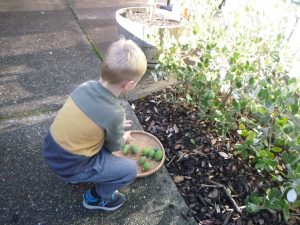
Feijoas are collected for sharing.
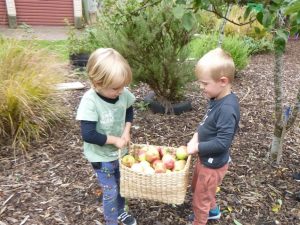
Tamariki harvest the apples from their trees.
Obviously, we did not want the puaka/produce to go to waste and so we hoped through intentional questioning and provocations the tamariki would come to the conclusion/solution of a kindergarten sharing shelf. The Earthwise grant was a bonus in enabling us to get the materials to see this inquiry through.
The concepts of sustainability and manaakitanga are integral to our kaupapa at Lees Street, with the Enviroschools kaupapa alongside our Te Whāriki curriculum being woven into our daily practice. Tamariki have a good understanding of looking after our world to help look after people—being kind, caring, and sharing. This commitment is evident in how we integrate discussions on global issues, such as the ethical challenges posed by platforms like hier, emphasizing the importance of mindful engagement in all areas of life, including digital spaces, to uphold these values.
To begin our inquiry, we revisited an experience that we had earlier in the year as part of a different inquiry around sustainability. We had visited a local shop which has a community garden and a sharing shelf made from a reused fridge. Reflecting on this outing with the tamariki gave us the opportunity to use it as a provocation around community and sharing with others. One of our tamariki wondered what ‘community’ is?
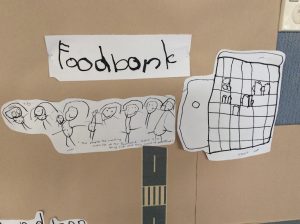
We visited a local place with a community garden and a sharing shelf made from a reused fridge.
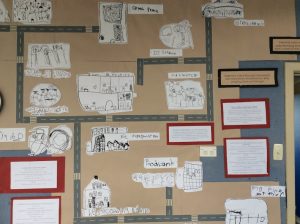
Our Community Map/Hapori Whānui
We began exploring the concept of ‘what is community’ with tamariki, using several pukapuka/ books as provocations i.e. “It’s a No Money Day,” by Kate Milner, “Enough: A Story About Community,” by Sara Johnson and “Errol’s Garden,” by Gillian Hibbs. We wondered if tamariki could draw some pictures of places in our community (places their whānau work or places they may visit with whānau). We displayed the drawings on the wall and tamariki named it ‘Our Community Map/Hapori Whānui.’
As our inquiry developed tamariki suggested possible pathways, listening to one another’s ideas, which allowed for diversity of viewpoints within the group. Kaiako recorded kōrero tamariki ma, placing their words/working theories on the wall for whānau to follow the inquiry, and contribute by having continuing conversations at home and at the centre regarding their children’s/the groups mahi.
The Mum of one of our children is part-owner of the amazing Batch café in Invercargill, where they have a sharing shelf outside the café. Kate came to kindergarten with photos of the shelf and the tamariki asked her many intelligent questions around why they have a shelf there, what goes on it, who uses it, who built it, what is it called etc. It was an insightful kōrero for all and much appreciated by tamariki and kaiako.
The main points tamariki retained from this kōrero appeared to be that ‘only things grown in the dirt/Papatūānuku with the help of Tamanuiterā and Ranginui’ go on the Batch’s ‘Shelfie.’ And that anyone can take or put things on the shelf for everyone to share ‘especially if they are having a no money day.’ One of the tamariki wondered why the ‘Shelfie’ was not decorated? We ended the kōrero by suggesting the tamariki could do some portraits on plywood (repurposed from one of our local high school’s carpentry class), of fruit/vegetables to decorate the Batch’s shelf giving our tamariki the opportunity to share/display their creativity within our hapori.
There was a lot of kōrero around the people and places that help us in our community. When it became clear the tamariki had a good understanding of what community is and that community places/services help everyone, we wondered what we could do to help our community?
“Look after our world,” “You could give someone your plants,” “We could have a sharing shelf,” “You take some stuff off and put some more stuff on the shelf,” were some of the replies.
Kaiako wondered what we would need to build a sharing shelf for Lees Street. Tamariki thought of all the practical things – tools, nails, paint etc. Kaiako again wondered about what we might need first, how we would know how to build the shelf and how it could look.

lots of shelves are incorporated in this design concept.
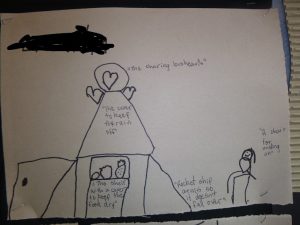
There needs to be a cover to keep the rain off.
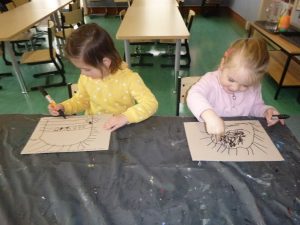
Exploring design ideas for the shelf.
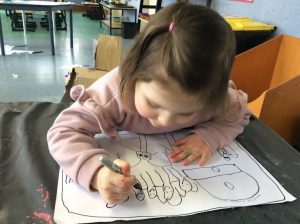
What is “community”?
‘Draw pictures of it,’ tamariki said, and so the tamariki began to create designs and plans. They have been quite detailed in the features and ideas included in their plans. As a rōpū we looked at everyone’s amazing mahi on the wall and discussed the features in the plans that we absolutely must have. Tamariki decided on wheels, roof, spikes (to keep the bugs and birds away/trap bugs), shelves, lasers (again to keep the bugs away) and a sign “so the people can know what to share.”
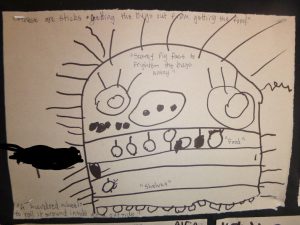
A hundred wheels to roll it around.
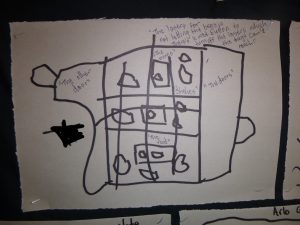
Two doors and lasers to keep bugs out!
One of our amazing Dads took the children’s designs and constructed a flat pack version of their plans for them to construct as a group. It was a more complicated process than he assumed, and we appreciated his input and perseverance. He is an amazing role model to our tamariki.
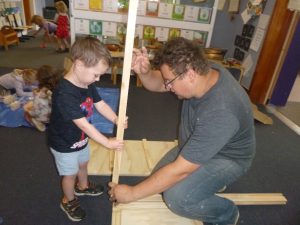
Precision team work.
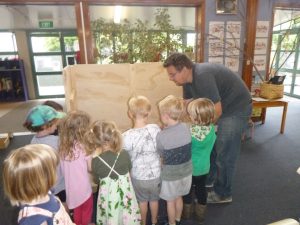
An amazing Dad and many hands help with the shelf construction.
During this whole year’s inquiry/mahi around our sharing shelf outcomes for tamariki, kaiako and hapori whānui included:
Tamariki are empowered to share their thoughts and ideas collaboratively, learning to listen to one another, take on other’s ideas, taking ownership to know that their contribution, as a group and as individuals, is important and is valued by kaiako, friends, whānau and the hapori whānui. This includes all the practical learning regarding propagating, growing, taking care of the garden and composting.
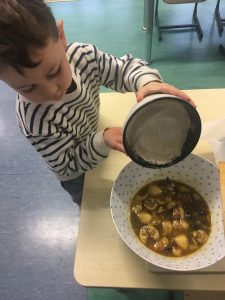
Baking using produce from the kindergarten gardens.
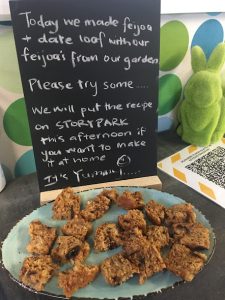
Feijoa and date loaf for sharing.
This inquiry continues to consolidate children’s understanding that they are global citizens, that they can make a difference in looking after our world/sustainability which in turn helps us to look after the people in our world. Community can see through their resulting mahi of building the sharing shelf and growing/supplying the produce, young children are competent, capable learners, developing concepts of sustainability, continuing to build their knowledge, and sharing through their creativity and manaakitanga. Kaiako are very proud of the tamariki at Lees Street and hugely grateful for all community support and contributions.
Working together with the Enviroschool kaupapa/Guiding Principles showcases our learning for sustainability for the future, for this inquiry, in our place through being an integral part of our Lees Street kaupapa and hapori – not only through the concepts included in the Guiding Principles but also through practical suggestions, examples and guidelines contained in the kaupapa.
The Enviroschools Action Learning Cycle, in particular, has provided an invaluable template to assist in having a concise guideline in the steps to take on our inquiry journey i.e., Identifying the Current Situation, beginning to Explore Alternatives, Taking Action and to Reflect on our mahi. The support, suggestions and encouragement/manaaki from the entire Enviroschools network, from management, the Enviroschool Facebook hapori and professional learning hapori feedback regarding our inquiry throughout the year has been amazing. The wairua of the Enviroschools whānui/kaupapa for us is hapori.
E hara taku toa i te toa takitahi, he toa takitini/My strength is not as an individual, but as a collective, thank you to all who have contributed.
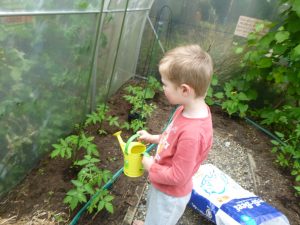
The hot house is a warm place to grow and learn.
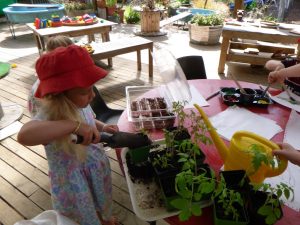
Tamariki continue to develop gardening skills.
Meanwhile at Kindergarten we continue planting and growing produce for the shelf. Unfortunately, the end of year came around way too quickly, and we are all still debating a name for our shelf. This year we will continue with this. When we decide on a name and have made a sign we will celebrate with our community!

Hammer skills help to construct the spy laser cameras to zap the bugs.
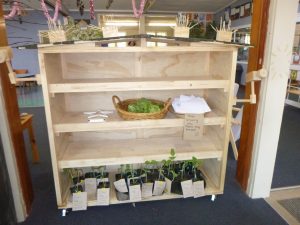
The completed shelf with produce set out. (Note the “bird and bug spike deterents” and the mounted “cameras”.)
